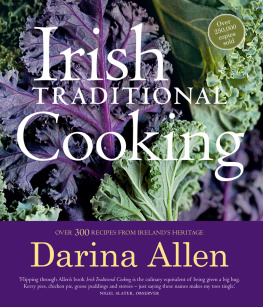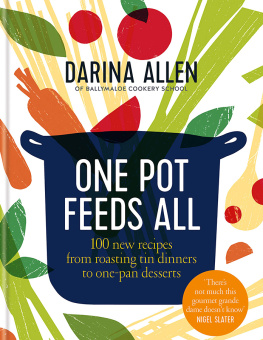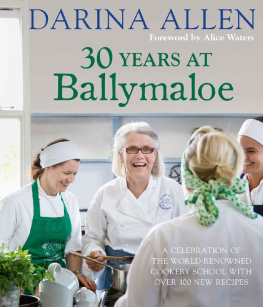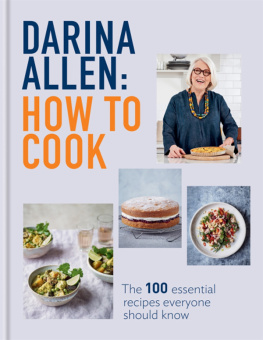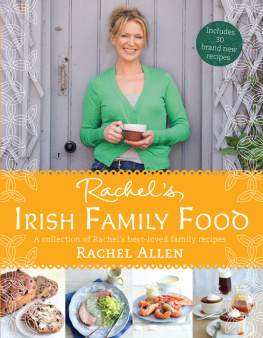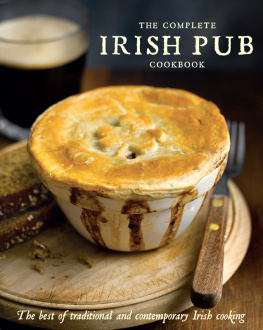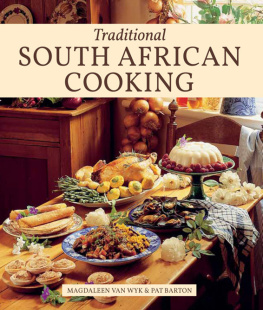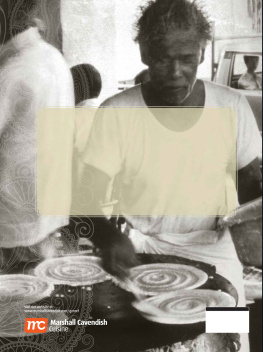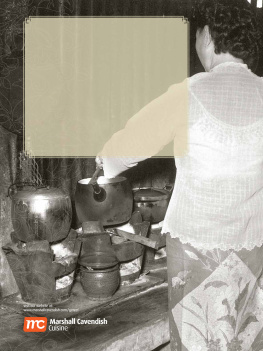Contents
Guide



Contents
How to use This Ebook
Select one of the chapters from the and you will be taken to a list of all the recipes covered in that chapter.
Alternatively, jump to the to browse recipes by ingredient.
Look out for linked text (which is in blue) throughout the ebook that you can select to help you navigate between related recipes.
You can double tap images to increase their size. To return to the original view, just tap the cross in the top left-hand corner of the screen.
Foreword
I suspect that, in common with most food lovers who did not have the good fortune to be reared in Ireland, the first Irish food name I ever heard was Allen. That was Myrtle Allen, of course, the legendary culinary pioneer of Ballymaloe House in Shanagarry, Co. Cork. She was a pioneer by simple virtue of the fact that, in 1964, she had the then absolutely revolutionary notion of presenting honest Irish raw materials and good homestyle cooking in a restaurant environment. Like Alice Waters in Berkeley about half a dozen years later, she also had the equally radical inspiration of actually basing her menu on ingredients that were in season and at their prime in effect letting the menu be dictated by the products.
The second Irish food name I ever heard was Allen, too this time Darina Allen. Ne Darina OConnell, in the ancient village of Cullohill in Co. Laois, Darina had, as she writes, a magical Irish country childhood. Helping milk cows and harvest fruits and vegetables, she grew up taking the idea of farm to table a recently discovered (or at least rediscovered) concept these days as a given. The fact that her mother was a wonderful cook added to her appreciation of good food, and she became adept in the kitchen herself.
As a young woman looking for employment, she happened to hear about a farm wife named Myrtle Allen down in County Cork who had recently opened a restaurant serving the kind of food she had grown up with. You could just about count the good restaurants in Ireland on one hand in those days, Darina once told me, and even the good ones tended to write the menu the day they opened and it would be exactly the same ten years later. Myrtle wrote her menu every day, which was seen as an amateurish thing to do. It sounded right to me, though.
A letter to Myrtle got Darina a job in the Ballymaloe kitchen. It was the perfect place for her, a serious restaurant expressing and elaborating on the culinary values she had grown up with. She not only thrived as a part of the Ballymaloe team but soon became part of the family too, literally, marrying Myrtles son Tim. In 1983, as the restaurant became increasingly successful and well-furnished guestrooms were added, turning Ballymaloe House into a gastronomes dream destination, Darina and Tim branched off and established a cooking school at nearby Kinoith farm today officially known as the Ballymaloe Cookery School and Gardens.
The school is hardly exclusively Irish. Students come from all over the world to study everything from beekeeping and pig butchery to vegetable (and rose) gardening, foraging, and food writing, and to learn the various arts of making tapas, pizza, and sushi, among many other foods. But Darinas passion her lifes work, one could say remains the cooking of her native country: the great, rich Irish traditions of artisanal food production (revived with great enthusiasm in recent years) and honest, skillful preparation.
As a popular television personality and a leading light in Irelands fast-growing Slow Food movement, as the founder of the first modern day Irish farmers market (at Midleton, not far from Shanagarry), and above all for those of us who know Darina mostly from afar as a prolific, ardently affectionate author of terrific cookbooks celebrating the best the Irish table has to offer (which is very good indeed), Darina is the most eloquent and credible champion of Irish cooking I can imagine. Writing with the kind of authority that comes from having lived her subject matter, Darina evokes the landscapes, personalities, and above all flavours of the Irish food world, and backs them up with the kind of clearly written, sensible recipes that only the experienced proprietor of a first rate international cooking school could manage.
If you have fond memories of good meals in Ireland, whether at home or out and about, this new edition of Darinas classic Irish Traditional Cooking will make your mouth water and your heart ache. If you are new to real Irish food, or are one of those benighted souls who doesnt believe that Ireland offers anything worth eating, I predict that this handsome volume will be a revelation to you, opening your mind and palate to a new world of culinary pleasure.
Colman Andrews, author of The Country Cooking of Ireland and editorial director of TheDailyMeal.com
Introduction
I had a magical Irish country childhood. I grew up in a tiny village called Cullohill, in Co. Laois, where all the neighbours helped each other during the busiest times of the farming year. Even as children we lent a hand with the haymaking and then took turns to ride home behind the hay cock on the horse-drawn cart. Threshing was still done with a steam machine, and I have many happy memories of helping to cook the enormous threshing dinner and bringing hot sweet tea and spotted dog to the men in the fields.
At home, almost everything we and our neighbours ate was fresh, wholesome food, homegrown or produced in the locality. We even had a house cow and our own hens. Every day, my mother cooked three wonderful meals on the range, which we all tucked into with great relish around the big kitchen table it needed to be big because there were nine of us. A packet of fig rolls or coconut creams from the shop were a rare treat.
Our summer holidays were spent, not in France or the Caribbean, but on an uncles farm in Co. Tipperary. For us, as children, it was an absolutely enchanting place a big working farm on the edge of the bog, where my great-aunt churned butter virtually everyday, they killed their own pigs, cured bacon and made black and white pudding, and my great-aunt did all the cooking over a huge open turf fire. The OConnell family of Noard was virtually self-sufficient up to the early 1960s.
Here I also learned the art of cooking in a bastible and how to make a tender railway cake speckled with plump sultanas. Here I learned how to hand-milk a cow, sitting on a three-legged stool with my forehead leaning against the cows warm stomach. As I write this I remember the sound of the milk squirting into the pail and the cows contentedly eating their ration of sweet hay. When the milking was finished, the milk destined for the creamery was put into tall churns and a few buckets were taken to the dairy to be run through the separator. The ripened cream of several days was then churned into rich golden butter, washed and salted. Great-aunt Lil painstakingly showed me how to use the timber butter-hands to shape the butter into little blocks and tiny pats for the house.
It never occurred to any of us that this way of life, which we took so much for granted, was about to come to an abrupt end. I can remember distinctly the day the first packets of instant whip and blancmange came to our village and we couldnt wait to try them. These foods had a glamour and a novelty value which made home cooking seem dull by comparison. All over Ireland, within just a few years, people began to prize fancy shop-bought goods. When the priest came to visit, for instance, he would always be offered white shop bread in preference to homemade soda bread. With the rush to embrace a new consumer culture of packet and tinned foods in the name of progress, a whole food tradition was jeopardised in an alarmingly short space of time. Through the 1950s and 1960s, rural electrification brought the added temptation of frozen foods to more remote areas. Official agricultural policy encouraged farmers to intensify to produce maximum yields at minimum cost to the detriment of flavour, texture and nutritional content.

